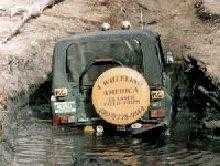
Most drivers' skill levels are compromised by their lack of actual 4x4 experience, and this is reflected in the ever present level of fear when going off-road. Fear of damaging the vehicle, fear of getting stuck and fear of getting lost.
Of course, there is no substitute for taking a proper 4x4 course, such as the Continental Academy or Land Rover Driving School, but the following should provide drivers with some of the essential basics:
Water is incompressible in an engine cylinder. So if water should ever enter your air intake, the results can be spectacularly expensive, to say the least.
Remember, petrol engines that have ingested water will stall in most cases, before damage occurs. In cases such as this, do not attempt to restart the vehicle. The vehicle? connecting rod (conrod), pistons or valves will bend and/or break .
It is therefore imperative to check the depth of water properly, before attempting to cross it. The rule of thumb is: If you can not walk it, you can not wade it.
This rule also applies to fast-flowing rivers which are impossible to safely walk across. Check for hidden rocks and potholes. Potholes are sometimes created by previous vehicles that started wheel spinning when they encountered a submerged or hidden rock.
Place markers where you find these in order to avoid them during the actual crossing.
If the depth of the water is more than the bumper height of your vehicle, additional preparations may be necessary, before entering the water, such as:
The last two pointers should be an absolute must for drivers who plan to do regular water crossings. Remember, when a hot axle hits the water, the cold water rapidly cools it and as a resultant the air pressure inside the axle and diff. housing lowers.
This sudden reduction in air pressure can actually suck water in via the axle seals if the diff breathers do not equalise the pressure fast enough. This in itself is another reason to allow the vehicle to cool down first before attempting a water crossing.
Driving at the correct (moderate) speed when water wading is imperative. Remember to wind down your window and take off your seat belt. Select low range, second gear and keep the revs around 2 000 r/min. As you enter the water, accelerate gently and do not create a splash that can wet electrical systems.
Drive at a steady speed as this will create a small bow wave in front of the vehicle. Should the vehicle start wheel spinning, gently ease off the accelerator to regain grip.
Do not change gear or momentum will be lost and water may enter the clutch housing and cause clutch slip.
Once you have successfully crossed to the other side some additional maintenance is essential for your 4x4 vehicle. Allow the vehicle to cool down and gently loosen the drain bolt of your diffs.
Remember, water is heavier than oil, and thus will collect at the lowest point of the diff. Drain off about 20ml and check to see if the diff. oil appears milky in colour.
This would indicate water contamination which means that your diff. needs to be flushed and the diff. oil needs to be replaced pronto! You may also want to check the gearbox, transfer case and engine oil for good measure.
If your 4x4 is equipped with an electric winch, it is advisable to strip it and grease it accordingly. Your winch may not be utilised for an extended period and you may find that it has seized up when called upon one day!
Finally, bear in mind that your brakes (especially drum brakes) may be wet and thus useless until they have dried out. This is especially important when a steep ascent or descent is planned immediately after the water crossing.




 Publications
Publications
 Partners
Partners














